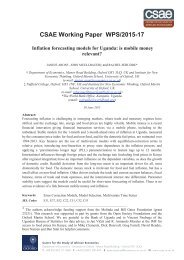You also want an ePaper? Increase the reach of your titles
YUMPU automatically turns print PDFs into web optimized ePapers that Google loves.
(a) The plane of level inflation rate and output gap<br />
for I = 0.00 (blue) and I = 0.07 (pink)<br />
(b) The plane of level interest rate and output gap<br />
for Π = 0.01 (blue) and Π = 0.03 (pink)<br />
Figure 8: Closed Economy Viability Kernel Slices<br />
dy<br />
dt<br />
= −0.06167y − 0.022286(i − π) + 0.0011955q (19)<br />
dπ<br />
= 0.044964y<br />
dt<br />
(20)<br />
dq<br />
= (i − π) − 0.23369u<br />
dt<br />
(21)<br />
di<br />
= i ∈ U = [−0.005, 0.005]<br />
dt<br />
(22)<br />
Figure 9a and 9b again show that the viability kernel V is quite large and similar in volume<br />
to the viability kernel for a closed economy model (see Figure 7). To see Figure 9 at a more<br />
detailed level, Figure 10 plots the viability kernels for the two extremes of level interest rates:<br />
I = 0.00 (pink) and I = 0.07 (blue). When New Zealand is in a recession with negative output<br />
gap and low inflation, a low nominal interest rate is needed to keep the economy within the<br />
viability kernel. Specifically, when New Zealand is operating close to full employment but with<br />
low inflation rate as high as 1.1% − 1.2%, a relatively low interest rate policy is also needed<br />
to keep the economy viable. According to the August 2016 Monetary Policy Statement, the<br />
32





